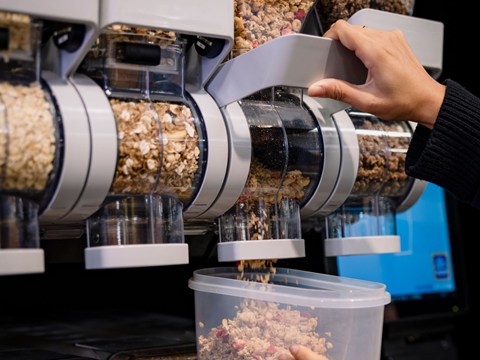
Switching 30% of grocery store goods into reusable packaging would lower packaging materials, waste, and emissions by 95% and reduce EPR costs, according to a study from GoUnpackaged, Berry, Tesco, Ocado Retail, and more.
An expert Advisory Panel consisting of Berry, WRAP, Tesco, Ocado Retail, Suez, WWF, Biffa, Innovate UK, CHEP, Ecosurety, DEFRA, and Reath helped examine several product categories and reuse scenarios, including coffee, ready meals, and shower gel.
The ‘data-driven’ study sought to provide an ‘objective and evidence-based’ view of the potential impacts of implementing reusable solutions. Now it claims to have revealed ‘significant commercial and environmental benefits’, with the sustainability outcomes and long-term savings believed to ‘significantly outweigh’ the required investments.
Apparently, converting 18 priority categories into 30 standardized packaging types could bring retailers to a 30% reuse target, at which point they are expected to achieve a 95% reduction in packaging materials and waste for the products in scope – reportedly eliminating over 300,000 tonnes of packaging waste annually.
In turn, CO2e emissions are anticipated to decline by 95%, equating to over 800,000 tonnes. At the same time, the study suggests that retailers could save between £314 million (€368,769,450) and £577 million (€677,643,225) in overall system costs compared to single-use; this is hoped to translate to a 12-22% saving.
Additionally, producers are expected to save £136 million (€159,721,800) in Extended Producer Responsibility fees for the products in question, while a switch to reuse is projected to create 13,000 net new jobs.
The report goes on to lay out key recommendations for industry and government to join forces and co-design a transition plan in order to meet the 30% reuse target by 2035. This would involve a joint effort between retailers, supply chain logistics, waste management, and local authorities.
Rob Spencer, co-founder of GoUnpackaged, comments: “It’s time to move on from debate and focus on the facts: Reuse works.
“Our study shows that switching just 30% of goods to reusable packaging is a huge opportunity for producers and retailers to win – environmentally, financially, and even societally, creating jobs and reducing waste.
“The data speaks for itself - taking all kinds of scenarios into account, our robust, industry-validated modelling shows the switch to reusable packaging will be universally positive.
“Reuse is the only viable option to significantly reduce packaging emissions, the volume of valuable materials we’re using, and the vast amount of packaging waste the UK collectively produces.
“That’s why we’re calling on the Industry and Government to work together and take action to move towards 30% reuse, starting now. There’s no excuse to delay tackling the single-use packaging crisis any longer.”
“The modelling results show, for the first time, an evidenced view of reuse working at scale in the UK for grocery retail, enabling industry and government to make insightful decisions about how to move forwards to co-create the necessary transition to reuse in the UK,” said the Advisory Panel in a joint statement.
“We look forward to bringing the value chain together in June to kick-start the discussion of the next practical steps towards wide scale reuse in the UK.”
In a previous edition of the Brief, we examined the Dutch Ministry of Infrastructure and Water Management’s ‘Reuse Roadmap 2030 for Supermarkets’, which guides the supermarket sector, producers, and adjacent parties through a potential transition into reusable packaging over the next five years. Standardized, centrally pooled reusable packaging, filled in advance and used interchangeably by producers and supermarkets, was described as the ‘ideal approach’, while consumer convenience, standardization, and traceability were highlighted as essential facets of a successful reuse system.
Previous research from environmental charity City to Sea suggests that 69% of UK consumers hold the government responsible for setting legally binding reuse and refill targets in order to tackle single-use packaging waste. Yet Calvin Lakhan, director of Circular Innovation Hub at York University’s Faculty of Environment and Urban Change, has also provided an overview of tackling the intention-action gap among consumers when it comes to reusables.
His advice included starting with food staples, where acceptance of reuse is currently at its highest, and transitioning other solutions into reusable packaging over time.
If you liked this story, you might also enjoy:
The ultimate guide to the Packaging and Packaging Waste Regulation in 2025
How are the top brands progressing on packaging sustainability?
Everything you need to know about global packaging sustainability regulation in 2025
The key to increasing the use of reusable packaging in supermarkets


















No comments yet